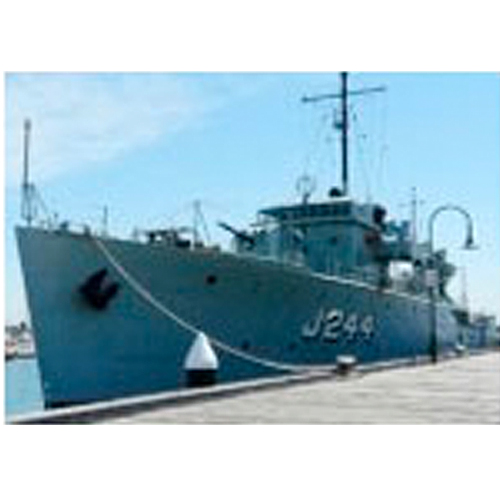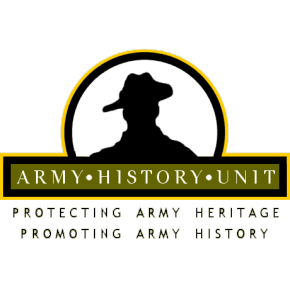
The HMAS Castlemaine is one of the 60 Australian-built Bathurst class corvettes to serve throughout World War Two and the last such vessel still afloat, having been restored by volunteers over three decades.
HMAS Castlemaine, berthed at Williamstown and open for public inspection allows visitors to explore an original World War 2 warship. She is one of the 60 Australian-built Bathurst class corvettes to serve throughout World War Two and the last such vessel still afloat, having been restored by volunteers over three decades. Castlemaineis open to the public on weekends and public holidays.
The Bathurst class corvettes were designed in Australia, based on the British Bangor class corvette and modified for local conditions. They were built primarily as mine sweepers, also capable of armed escorts, landing and embarking troops and supplies ashore, and, when the scourge of enemy submarines was realised, anti-submarine warfare. To this end, HMAS Castlemaine was an economical ship which could operate in both open and shallow coastal waters and was armed with proven and reliable anti-aircraft guns, depth charge launchers and the QF 4 inch deck gun which fired a range of specialised ammunition. The class was officially designated ‘Australian Mine Sweeper’.
Her small crew, initially of 70 was expanded to nearly 100 owing to the equipment added to the corvettes during the war such as radar and ASDIC, an early form of sonar.
It is fitting that she is berthed in perpetuity at Williamstown, where she was built and subsequently launched on the 7th of August 1941 by Mrs. R. G. Menzies, wife of the then Prime Minister and that her engines were built, in the town for which she is named- Castlemaine, located some 140km north west of Melbourne. Throughout her service career she suffered minor damage to enemy actions, was involved in a collision with a ferry in Manly, Sydney, ran aground near Millingimbi off the coast of Arnhem Land and was involved in the same action in which HMAS Armidale, one of her sister ships was sunk off the coast of Timor.
Today visitors can see how crews lived and worked during the war years, witness the original engines turning over and view a wide range of artefacts documenting Australian maritime history.
HMAS Castlemaine, open from 10AM every weekend, is located on Gem Pier in Williamstown.
Gates close to visitors at 4pm.
Admission Prices – Adults: $6, Children Under 16: $3, Families: $15, children under 4: free
The HMAS Castlemaine is one of the 60 Australian-built Bathurst class corvettes to serve throughout World War Two and the last such vessel still afloat, having been restored by volunteers over three decades.
HMAS Castlemaine, berthed at Williamstown and open for public inspection allows visitors to explore an original World War 2 warship. She is one of the 60 Australian-built Bathurst class corvettes to serve throughout World War Two and the last such vessel still afloat, having been restored by volunteers over three decades. Castlemaineis open to the public on weekends and public holidays.
The Bathurst class corvettes were designed in Australia, based on the British Bangor class corvette and modified for local conditions. They were built primarily as mine sweepers, also capable of armed escorts, landing and embarking troops and supplies ashore, and, when the scourge of enemy submarines was realised, anti-submarine warfare. To this end, HMAS Castlemaine was an economical ship which could operate in both open and shallow coastal waters and was armed with proven and reliable anti-aircraft guns, depth charge launchers and the QF 4 inch deck gun which fired a range of specialised ammunition. The class was officially designated ‘Australian Mine Sweeper’.
Her small crew, initially of 70 was expanded to nearly 100 owing to the equipment added to the corvettes during the war such as radar and ASDIC, an early form of sonar.
It is fitting that she is berthed in perpetuity at Williamstown, where she was built and subsequently launched on the 7th of August 1941 by Mrs. R. G. Menzies, wife of the then Prime Minister and that her engines were built, in the town for which she is named- Castlemaine, located some 140km north west of Melbourne. Throughout her service career she suffered minor damage to enemy actions, was involved in a collision with a ferry in Manly, Sydney, ran aground near Millingimbi off the coast of Arnhem Land and was involved in the same action in which HMAS Armidale, one of her sister ships was sunk off the coast of Timor.
Today visitors can see how crews lived and worked during the war years, witness the original engines turning over and view a wide range of artefacts documenting Australian maritime history.
HMAS Castlemaine, open from 10AM every weekend, is located on Gem Pier in Williamstown.
Gates close to visitors at 4pm.
Admission Prices – Adults: $6, Children Under 16: $3, Families: $15, children under 4: free






